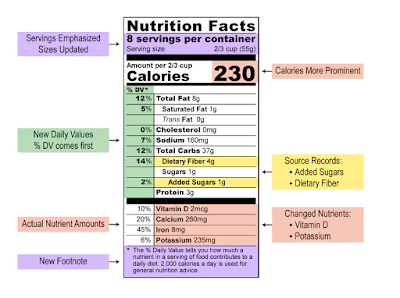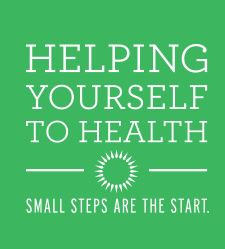Understanding Food Labels
1. Check the serving size.
This is what the entire label is based on. This tells you how much everything equals. It can range from five pieces or the whole package. A serving size is a measured amount of food. It's what the USDA uses in the Healthy Eating Guidelines and daily recommendations. However, food label serving sizes are determined by the manufacturer so they may not match the USDA guidelines.
2. See the calories.
Now that you know what counts as serving, you can see how many calories a serving equals. Remember to multiple this number by the number of serving you plan to eat! A good rule of thumb is, if the calories are high - for example more than half the amount you estimate for the whole day - then that particular food might not be a good choice on a regular basis.
3. Keep an eye out!
- Fat - Some fats, namely saturated fat and trans fat, are worse than others (mono unsaturated fat and polyunsaturated fat). Too much total fat is also not healthy. So, in full disclosure, you will always see grams of total fat, saturated fat and trans fat listed on a Nutrition Facts Label. This is required by law so that consumers are aware and can choose to avoid products high in total fat, saturated fat and trans fat.
- Cholesterol - Cholesterol is listed on the label in milligrams. A low cholesterol food is defined by the Food and Drug Administration as 20 milligrams or less per serving. When reading labels, it may be helpful to remember that cholesterol only comes from animal products. You may also see "0 grams" of cholesterol and at first think a product is healthy, but that product may still be high in saturated fat and trans fat.
- Sodium - Sodium is listed on the label in milligrams. When 1500 milligrams is the limit for people with heart disease, sodium can add up quickly. A low-sodium food is defined by the Food and Drug Administration as 140 milligrams or less per serving. This can be a helpful frame of reference when deciding if and how a certain product can fit into your healthy eating plan.
4. Get enough of these.
Most Americans don't get enough dietary fiber, vitamin A, vitamin C, calcium and iron from foods. Of these, dietary fiber is important for heart health. But while following a heart-healthy diet, you don't want to neglect other nutrients important for general health. The Nutrition Facts Panel can help you identify which foods contain some of these important nutrients.5. The Footnote.
The footnote on the lower part of the nutrition facts panel tells you that "Percent Daily Values are based on a 2,000 calorie diet." This footnote is the same on every food product, although it may not always have the numerical details below it if a food package is too small to fit it all.6. Percentage per serving.
Strive to have low daily values of fat, cholesterol and sodium. Aim for higher daily values of dietary fiber and vitamins. 5% of daily value is low. 20% or more is high.Package Claims:
"Lean and light" - Lean equals less than 10 grams of fat, 4 grams of saturated fat and 95 milligrams of cholesterol per serving. A light product has 1/3 less calories or no more that 1/2 the sodium of a regular product.
"Sodium free", "low sodium" and "very low sodium"- Sodium free equals less than 5 milligrams of sodium per serving. Low sodium has less than 140 milligrams of sodium per serving. Very low sodium has less than 35 milligrams of sodium per serving.
"Cholesterol free" and "low cholesterol" - Cholesterol free has less than 2 milligrams of cholesterol or 2 grams or less of saturated fat per serving. Low cholesterol has less than 20 milligrams of cholesterol per serving.
"Good Source" - This indicates that a serving contains 10% to 19% of the daily value of a nutrient.
"Sodium free", "low sodium" and "very low sodium"- Sodium free equals less than 5 milligrams of sodium per serving. Low sodium has less than 140 milligrams of sodium per serving. Very low sodium has less than 35 milligrams of sodium per serving.
"Cholesterol free" and "low cholesterol" - Cholesterol free has less than 2 milligrams of cholesterol or 2 grams or less of saturated fat per serving. Low cholesterol has less than 20 milligrams of cholesterol per serving.
"Good Source" - This indicates that a serving contains 10% to 19% of the daily value of a nutrient.
New Label Information!
Many of you may have noticed the change in food labels on packaged products. The Food and Drug Administration (FDA) has made some updates to the 20-year old food label that should be completely in effect by July 2018. Some of the changes are summarized below, if you want more information about the change in food label check out the FDA Nutrition Label Website.- Serving size is larger and bolder with serving size updated. Serving sizes have changed since the first food label was created, so the FDA has decided to reflect a more realistic serving size for today’s consumers.
- Added sugar is now listed. The new nutrition label informs consumers about the sugar added to their product. This separates natural sugars and those added when processing and packaging.
- The footnote has changed. The FDA believes the new wording of the footnote will make it easier for the average American to comprehend.




.jpg)
Comments
Post a Comment